Clear Skies in La Palma
- By Koji Mukai
- August 25, 2010
- Comments Off on Clear Skies in La Palma
I’m a new blogger for Blueshift – I work for the Japanese-US Suzaku X-ray astronomy project here at Goddard, and have done education and outreach related works over the years. I used to do ground-based optical observations, so I decided to write about my visits to the international observatory on the island of La Palma.

Looking south from Roque de los Muchachos, over the caldera, towards the south end of La Palma. We are above the low clouds. 1995 June.
But let me back up. After finishing my undergraduate degree in Japan where I spent the first 22 years of my life, I went to England for my graduate studies. One day in February, I think, my first winter in Oxford, I was walking down Cornmarket Street around lunch time, and noticed how low the Sun was. Of course, I thought, we are at such a high latitude compared to what I’m used to in Japan. But why hadn’t I noticed this before? Because I hadn’t seen the mid-day Sun in England very often during the first six months of my time there – it’s cloudy so much of the time!
It makes you wonder how Britain managed to establish such a grand tradition of astronomy. Isaac Newton may have been a theorist, but Edmond Halley surely must have observed the comet that bears his name. William Herschel discovered Uranus (among many, many accomplishments) from his house in Bath. John Russell Hind discovered 10 out of the first 30 asteroids known to mankind, all from an observatory in Regent’s Park, London. How did they, and other noted British astronomers, manage such feats from so cloudy a country? Nobody knows the answer. For the British astronomers of the late 20th century, a better question to ask was: where can they build a modern observatory to remain at the forefront of astronomical research?
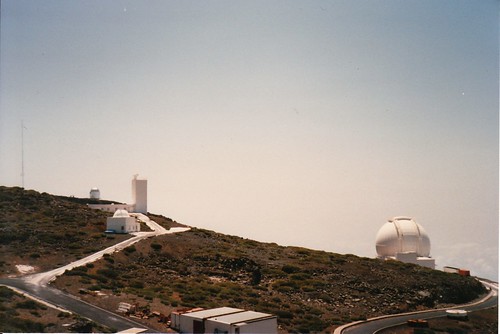
Picture taken from a similar position as the above one. The Swedish solar telescope is the tower, not sure what the two small domes near it are.
For the northern hemisphere, they settled on La Palma, one of the Canary Islands off the northwest coast of Africa. It’s a rugged, volcanic island that is much less developed than the neighboring Tenerife, which is full of sun-seeking European tourists. The international observatory is situated near the highest peak on La Palma, Roque de los Muchachos (the rock of the boys), about 2,400 m (8,000 ft) above sea level. At such an altitude, you are often above clouds that hug the coast line. The air above is very stable, due to the influence of the surrounding ocean, so the seeing is excellent – that is, stars twinkle much less, and so long-exposure images are sharp. The occasional annoyance of dust blown of the Sahara notwithstanding, the Roque de los Muchachos observatory is one of the best sites for ground based optical and infrared observations in the world.
 Another (hazy) view from Roque de los Muchachos.
Another (hazy) view from Roque de los Muchachos.
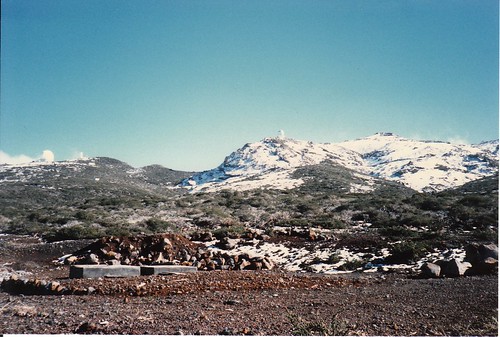
Snow-covered observatory, taken from the front of the Residencia (astronomer’s sleeping quarters), 1988 Dec.
Towards the end of my first full year in Britain, I got the chance to travel to La Palma for a week of observing. It was a memorable trip for me, because this was my first ever observing run at a professional observatory. It was also the early days of the Roque de los Muchachos observatory. They hadn’t built the Residencia – astronomer’s sleeping quarters – yet, so we stayed in a tin hut with walls so thin that, it was said, “you could hear your neighbor tie his shoe laces.” Also, the tracking system of the 1m telescope – one of the two we used that week – was still being worked on, so somebody (me) had to stay on the floor of the telescope dome and manually adjust the telescope pointing once every few minutes. It’s not as comfortable as sitting in a control room, but it was wonderful seeing the clear night sky through the opening of the dome all night. Delphinus (the dolphin), a tight constellation of 5 4th magnitude stars, became my favorite. After the end of the run, we shared a ride with a French astronomer, down the winding, unpaved, and dusty road. When we re-convened for dinner, he said, “Ah, that was the best shower I’ve ever taken.”
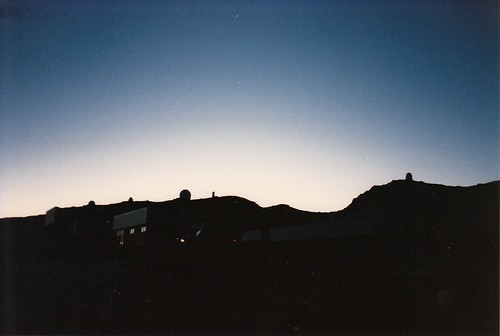
Telescope domes in silhouette, at dawn I think.

Clouds try to come over the peak.
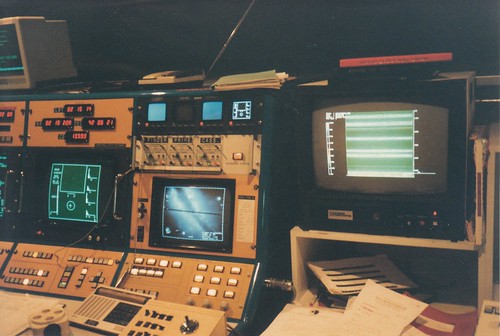
The control room of the 2.5 m Isaac Newton Telescope. We were observing a supernova in the dust lane of an edge-on spiral galaxy, I think.
Over the next several years, I observed on La Palma on half a dozen other occasions. Now I am mostly a stay-at-your-computer X-ray astronomer. I miss my days of hands-on optical astronomy.
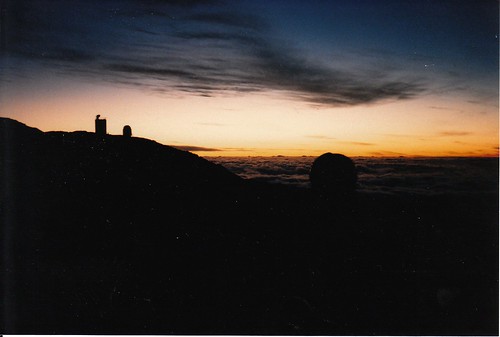
Another dawn shot, with the domes.

Driving down to Santa Cruz de La Palma via the western end of the island, through the caldera. This was at the end of my last trip to La Palma in 1988 Dec/1989 Jan.
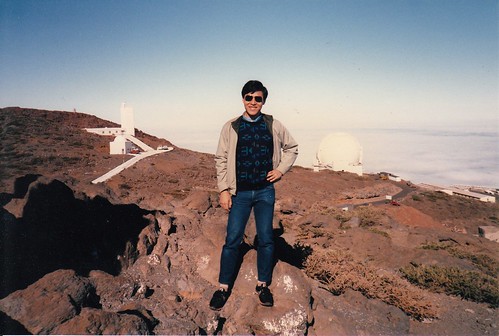
Me, near the east end of the observatory ground, I think, with the 4.2 m William Herschel Telescope (right) and the Swedish solar telescope (left). 1995 June?
PS. If the above gave you the impression that it’s always cloudy in England, that’s obviously exaggeration. There are wonderful, sunny days there, too. It’s just that there aren’t enough such days – and nights – to satisfy the needs of astronomical research.




